A Core Competency for the Digital Century
The rapid advancement of artificial intelligence transforms societies, industries, and individual lives across the world. From automating routine tasks to solving complex problems, AI has been at the forefront of driving innovation in the fields of healthcare, education, finance, and entertainment, among others. This line of progress raises the relevant idea of AI literacy for success in a world going through increasing AI.
AI literacy is more than just understanding the technical mechanisms in artificial intelligence; it refers to the ability to use AI tools effectively, to critically evaluate their output, and to deal with the ethical and societal challenges that result from these. This comprehensive chapter goes on to explain the meaning of AI literacy, its importance, basic principles, main applications, and the ethical dimensions it covers.
Characterizing AI Literacy
Fundamentally, AI literacy is the knowledge and skills needed for understanding, interacting with, and critically assessing artificial intelligence systems. That idea contains a really large space of competencies, from technical to ethical awareness and social responsibility.
In the early years of AI development, AI literacy was mostly possessed as a competitive advantage belonging only to specialists in certain fields. As AI is integrated into daily life increasingly, the skill set has become as fundamental as digital literacy or numeracy. Individuals, organizations, and societies all need to adopt AI literacy if they want meaningful engagement with today’s digital landscape.
Critical Elements of AI Literacy
- Technical knowledge: Understanding how AI systems, especially machine learning models, are trained and how they work.
- Practical Application: Acquisition of ability in using AI tools for a wide range of purposes, from task automation up to decision-making improvement.
- Critical Thinking: Checking AI-generated outputs for its exactness, relevance, and possible biases.
- Ethical and Social Awareness: Awareness of the broader implications of artificial intelligence, including issues of fairness, accountability, and societal impact.
- Adaptability: Keeping up with the fast evolution of artificial intelligence technologies and easily integrating new tools into all fields.
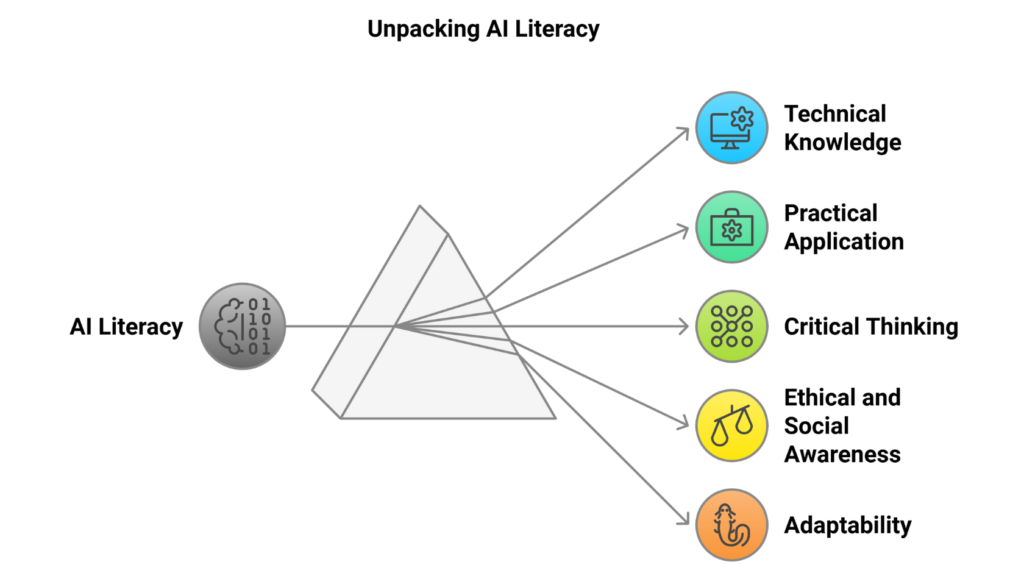
The Importance of Large Language Models for Artificial Intelligence Mastery
The mastery of large language models is core to the understanding of AI today. They are among the most impactful, widespread technologies currently reshaping how people and organizations interact with digital content.
What Are LLMs?
LLMs are the complex machine learning models showing strong performance in the processing and generation of human-like text. Having been trained on very large datasets containing textual and coded materials, LLMs can perform a wide variety of tasks, such as text summarization, language translation, content creation, or even dialogue.
LLMs such as OpenAI’s GPT-4, Google’s Bard, and Meta’s LLaMA represent the cutting edge of AI development, offering powerful tools for professionals and enthusiasts alike. Understanding how these models work and their applications is a cornerstone of AI literacy.
How LLMs Work
Two things mainly determine the performance of LLMs:
- Quality and Diversity of Data:
The quality and variety of the training data are important for the model to produce accurate and contextually correct results. A model trained on more and less biased data, for example, has a higher probability of consistently producing valid results.
- Computing Power:
Training and deploying LLMs calls for behemoth computational resources. Advances in hardware, including GPUs and TPUs, have enabled the development of increasingly complex models capable of tackling intricate tasks.
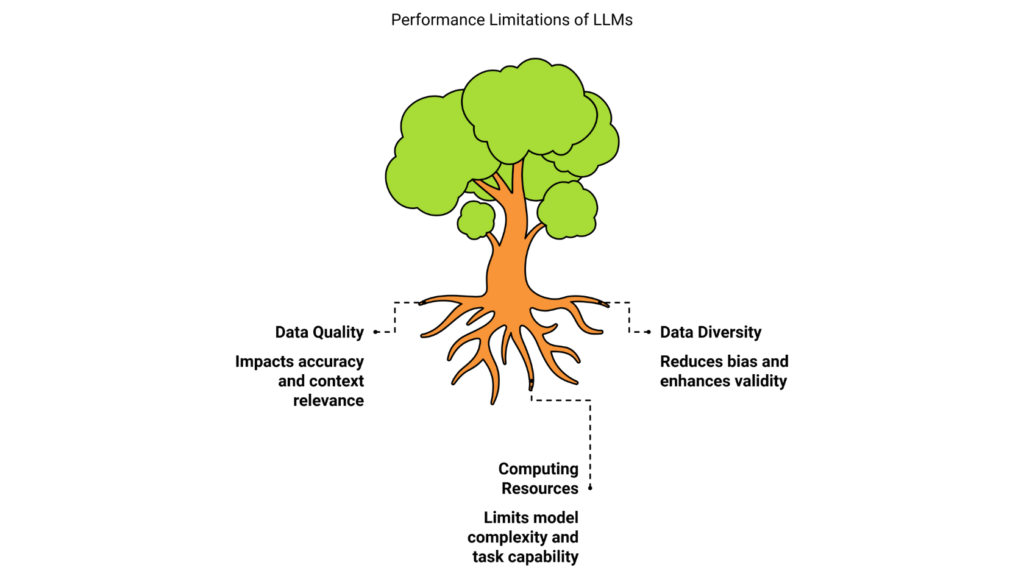
Applications of LLMs
What makes LLMs versatile is their wide range of applications across various industries and domains. Here are some of the important use cases:
- Conversational Agents and Digital Assistants
LLMs underlie the conversational agents that can be used for answering customer queries, providing technical support, and even companionship. Examples include ChatGPT and voice assistants like Alexa and Siri.
- Content Creation:
LLMs are used in several applications to create written content, which may include blog posts, reports, and marketing copies, and even poetry, thereby saving time and enhancing creativity within workflows.
- Language Translation:
AI-driven translation tools, such as Google Translate, harness these LLMs for accurate and context-aware translations, tearing down language barriers in global communication.
- Code Generation and Debugging:
They generate code snippets, automate repetitive programming tasks, find bugs, make developers much more productive, and reduce errors.
- Sentiment Analysis and Text Classification:
It’s used by companies to analyze customer feedback, monitor social media sentiment, and organize large datasets for actionable insights.
- Education and Personalized Learning:
AI tools powered by LLMs offer personalized tutoring, curriculum development, and automated grading, revolutionizing the education sector.

Open-Source vs. Proprietary Models
One of the fundamental building blocks in AI literacy is familiarity with the differences between proprietary and open-source AI models. Each approach has certain advantages and limitations that influence its usability and accessibility.

Proprietary Frameworks
Proprietary artificial intelligence services, including OpenAI’s ChatGPT and Google’s Bard, offer impressive functionality along with accessible user interfaces. Such models are particularly well-suited for both individuals and organizations in pursuit of dependable, ready-to-use solutions.
Advantages:
- High reliability and performance.
- User-friendly interfaces requiring minimal technical expertise.
- The service provider carries out periodic updates and maintenance activities.
Disadvantages:
- Not too customizable.
- Subscription fees or pay-per-use charges.
- The underlying model as well as the training data are unavailable.
Open-Source Models
Open-source alternatives, such as Hugging Face’s pre-trained models or Meta’s LLaMA, offer unparalleled flexibility and transparency. They are ideal for advanced users who require tailored solutions.
Advantages:
- Completely customizable and in control of the model.
- Availability of underlying code and data sets.
- Economically viable for wide-scale deployments.
Disadvantages:
- Requires significant technical expertise and resources.
- The maintenance and updates rely on the community or user efforts.
Bearing the differences in mind, it is able to enable one towards making a decision that suits their goals and resources.
Advanced Techniques of LLM Optimization
This entails advanced methodologies namely prompt engineering and retrieval-augmented generation (RAG) to fully exploit the potential of LLMs.
Prompt Engineering
Prompt engineering is the design of accurate and efficient inputs that guide the outputs of an LLM. A good crafted prompt will greatly enhance the quality and relevance of the responses obtained, mainly in content creation and chatbot applications.
For example, instead of making a request to an LLM to write “a story,” a user might enter a very specific request like:
- Write a 500-word story about a scientist who discovers a cure for a rare disease, set in a futuristic city setting.
- This level of specificity allows the model to generate more focused and substantive content.
Retrieval-Augmented Generation (RAG)
Combining generative capabilities of LLMs with external sources of data, this method makes the model more precise and less prone to error. This is most important in such scenarios where current or site-specific information might be needed.
For instance, a medical RAG-based chatbot may fetch knowledge from the latest research papers in order to answer questions as accurately and evidence-based as possible. Through the integration of external knowledge, RAG suppresses the possibility of “hallucinations” (made-up responses) and assures that the artificial intelligence remains trustworthy.
Ethical Issues in Artificial Intelligence Literacy
Ethical awareness is a cornerstone of AI literacy. The ethical implications of AI systems will have to be addressed as these systems become more pervasive for responsible development and deployment.
Bias and Fairness
AI models may, at times, unconsciously perpetuate biases in their training data, which might lead to outcomes that are not fair or just. An AI hiring tool might, for example, be biased toward one demographic if its training data reflects past discrimination. Equipping AI systems with fairness requires rigorous testing and relentless monitoring.
Clearness and Accountability
AI literacy will empower users to demand transparency in AI operations in order to create trust and accountability. Understanding how AI systems make decisions enables users to identify potential biases, inaccuracies, and areas for improvement.
The Way Ahead
AI literacy moves beyond technical competency and represents a critical tool for navigating an increasingly digital world. Through the understanding of underlying AI principles, advanced methodologies, and taking on issues of ethics, people have the capability to harness the disruptive capabilities that exist in AI technologies.
This would ensure that society is AI-literate and, therefore, communities can take part in shaping the future of AI toward responsible and inclusive applications. An active engagement will be very important in addressing opportunities and challenges brought about by AI, while ensuring that it serves the greater good.
Of course, education and training play an important role in AI literacy.
For AI literacy to become widespread, educational and training systems would have to consider the infusion of knowledge concerning AI into their curricula: ensuring that all ages and walks of life understand and interact appropriately with AI technologies.
Embedding AI Literacy in Schools
- Preliminary Awareness:
The introduction of artificial intelligence concepts in both elementary and secondary education serves to clarify the technology and stimulate interest in young students. Instructional content that simplifies subjects such as machine learning and ethical considerations in AI can establish a robust groundwork for subsequent advanced learning.
- Project-Based Learning:
The more practical projects, such as building simple AI models or trying out chatbots, would make the students understand the practical applications in AI. Such activities develop critical thinking and problem-solving skills.
- Ethics in the Classroom:
In essence, it is teaching ethics that involves AI makes responsible use happen. Arguments over privacy, bias, and impacts of AI systems on society make students understand broader implications that surround technology.
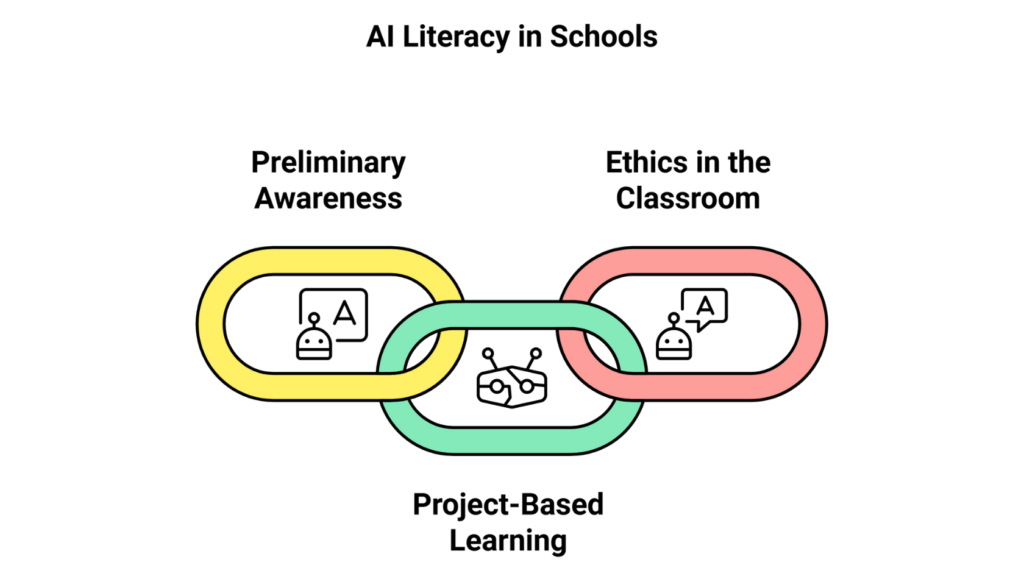
Upskilling the Workforce
Professionals have to become literate in AI if they wish to remain competitive in the current job market. Most industries demand a worker be able to interact with AI tools, draw insights from data-driven sources, and incorporate AI solutions into workflows.
- Corporate Training Programs:
Companies invest in training schemes, showing the employees how to work with AI tools effectively and ethically. For example, the workshops on using LLMs for content generation or data analysis may be done in order to increase productivity and innovation.
- Learning Management Systems:
There exist courses giving foundational lectures on AI, machine learning, and the ethics surrounding AI that are found on Coursera, edX, and Udemy, and it can continue learning at any skill level.
- Occupational Qualifications:
Certificates in the field of artificial intelligence, like machine learning engineer and data science, reflect excellent expertise and open avenues for further career development. Nowadays, most organizations view such qualifications as their assets.
Understanding AI Literacy for Policymakers and Leaders:
AI literacy is not only a matter of concern for technologists; it is also of great importance to policymakers, business leaders, and community leaders who decide the strategic direction of AI development and deployment.
Policymaking and Regulation
Policymakers who understand artificial intelligence can harmonize innovation with ethical considerations while creating policy. Some of the most important areas include:
- Privacy Laws: Making sure AI systems comply with data protection regulations such as GDPR in Europe.
- Bias Mitigation: Forcing transparency and fairness into artificial intelligence algorithms to prevent prejudiced outcomes.
- Accountability Frameworks: Establish norms for AI developers and users in being responsible for the actions of their systems.
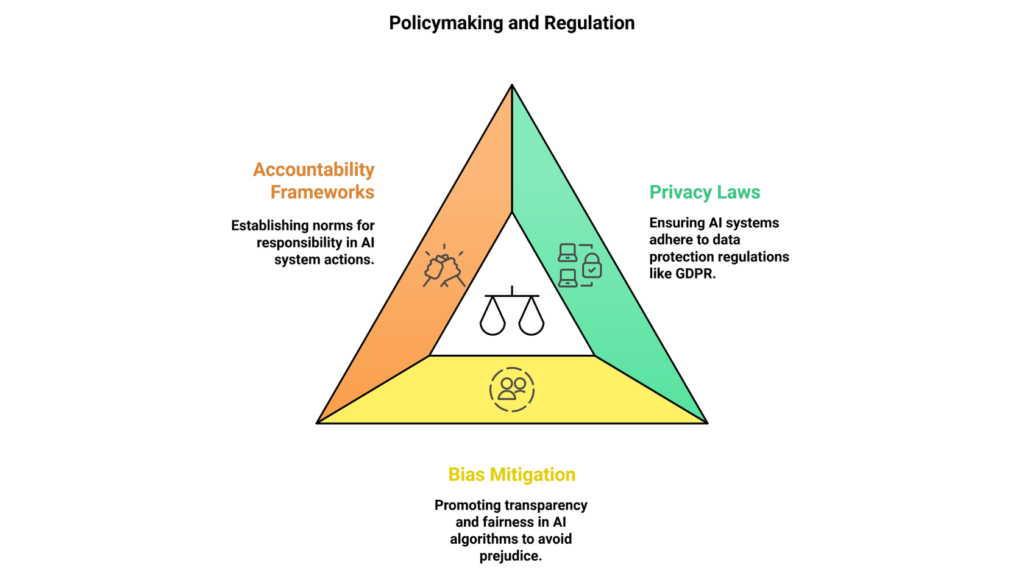
Leadership in Business
This is how it will empower business leaders to make strategic decisions. Leaders with AI literacy can generate opportunities for innovation, assess risks and benefits of the use of AI solutions, and build a culture of ethical use of AI in their organizations.
Community Participation and Social Awareness Community-level AI literacy will be important to ensure equitable accessibility of benefits from AI technologies for all citizens, regardless of socioeconomic background. Public awareness campaigns and accessible resources can demystify AI and encourage inclusive participation.
- Community Workshops: Such workshops on the ground—teaching the basics of AI—can be easily hosted by a local organization. These sessions can help bridge the digital divide and empower underserved communities.
- Public Awareness Campaigns: Such efforts may be led by governments and NGOs and concentrate on applied aspects of AI in areas like health care improvement or public services enhancement.
- Accessible Resources: Also, creating easy-to-understand guides, videos, and interactive tools can make AI literacy possible for a non-technical audience.
The Artificial Intelligence Literacy of Tomorrow As artificial intelligence technologies advance, expectations from persons and communities in understanding and engaging with them responsibly will also rise.

The following articulates some developing trends and challenges of AI literacy:
Continuing Education
AI literacy is not a one-time achievement but an ongoing process. With rapid advancements in AI, individuals must commit to lifelong learning to stay informed about new tools, techniques, and ethical considerations.
Artificial Intelligence in New Technologies
the Internet of Things (IoT)–are going to necessitate increases in AI literacy. Understanding connections like these will be important for maximizing their joint potential.
International Cooperation
AI literacy initiatives must go beyond national borders with international cooperation in order to deal with issues such as bias, data sovereignty, and equitable access to AI resources.
Ethical Dilemmas
This will make the ethical challenges increasingly complex. Literacy in AI, therefore, needs to cover critical evaluation of such challenges and argumentation for responsible solution paths.
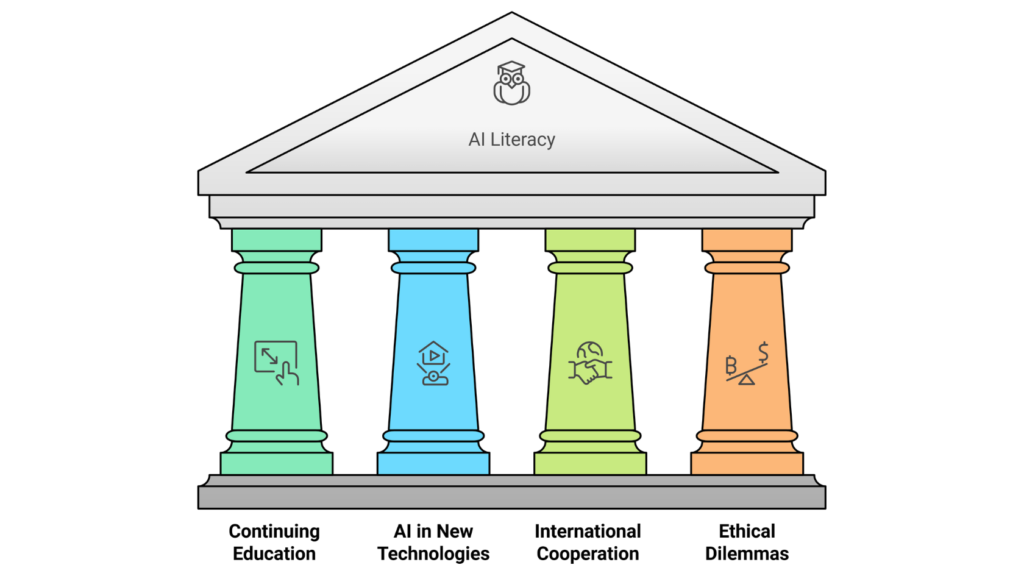
Embracing AI Literacy for a Responsible Digital Future
AI literacy is more than just a technical capability-it’s an overarching capability that enables the fully fluent use of AI and its secondary consequence: it aligns with the long-term changes it can cause. Knowing how AI systems work, advanced prompt engineering techniques, and even RAG, could be tapped into bringing improved life enhancements and solutions to many complex problems that raise ethical issues. Similarly, public awareness of AI literacy will mean that global communities can actively participate in shaping the future of artificial intelligence. From educational frameworks and workforce development to policymaking and public awareness, AI literacy is the key ingredient for a more inclusive, equitable, and creative digital society. In looking to the future, the development of AI literacy will empower not just adaptation to advances in technology but leadership of them, ensuring that artificial intelligence will function in ways that are ethical, transparent, and beneficial to society at large.
References
- E-Book from Databrick: A Compact Guide Large Language Models
- E-Book from Databrick: The Big Book of MLOps
- E-Book from Databrick: The Big Book of GenAI
- https://www.denkfabrik-bmas.de/fileadmin/Downloads/Publikationen/AI_Literacy_Kompetenzdimensionen_und_Einflussfaktoren_im_Kontext_von_Arbeit.pdf
- https://www.sciencedirect.com/science/article/pii/S2666920X21000357
- https://www.datacamp.com/blog/what-is-ai-literacy-a-comprehensive-guide-for-beginners
Author: Yunus Emre Karahalil















